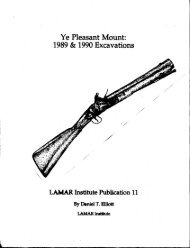Stirring Up a Hornet's Nest: - UGA Laboratory of Archaeology ...
Stirring Up a Hornet's Nest: - UGA Laboratory of Archaeology ...
Stirring Up a Hornet's Nest: - UGA Laboratory of Archaeology ...
Create successful ePaper yourself
Turn your PDF publications into a flip-book with our unique Google optimized e-Paper software.
Arms Group<br />
The common militiaman in the American Revolution was lightly equipped. An April 6, 1779 list <strong>of</strong><br />
“Articles <strong>of</strong> Equipment” that were to be provided to the Continental soldiers in the northeast included the<br />
following items:<br />
A good Fire-Arm, with a Steel or Iron Ram-Rod, and a Spring to retain the same, a Worm, Priming wire and Brash, and a<br />
Bayonet fitted to your Gun, a Scabbard and Belt therefor, and a Cutting Sword, or a Tomahawk or Hatchet, a Poach [pouch]<br />
containing a Cartridge Box, that will hold fifteen Rounds <strong>of</strong> Cartridges at least, a hundred Buck Shot, a Jack-Knife and Tow<br />
for Wadding, six Flints, one pound powder, forty Leaden Balls fitted to your Gun, a Knapsack and Blanket a Canteen or<br />
Wooden Bottle sufficient to hold one Quart (Hopkins 1940:19).<br />
A variety <strong>of</strong> battlefield weapons and relics in the Arms Group have been discovered and taken from the site<br />
in the 229 years since the battle ended. Bowen noted that, “For a long time, pieces <strong>of</strong> muskets, <strong>of</strong> bayonets,<br />
and also musket balls were picked up at the battlefield <strong>of</strong> Kettle Creek” (Hays 1950:18). Oral history<br />
provided by former Kettle Creek area residents Henry Nichols and Eloise Slaton in 1974 to Davis and<br />
Thomas (1975:95) included recollections <strong>of</strong>, “gun barrels, bullets, dishes etc. being found in the area.” We<br />
cannot determine the percentage <strong>of</strong> battlefield relics that were removed by people in years past, although it<br />
probably represents a significant percentage <strong>of</strong> the total. Bear in mind, however, that the entire battle event<br />
took less than four hours, it included no entrenchments, and the victors (and later residents) scoured the<br />
battlefield and collected weapons and other valuable materiel.<br />
To illustrate one type <strong>of</strong> object that was likely removed from the battlefield, collector and artifact merchant<br />
Childs provided an unconfirmed report <strong>of</strong> a spontoon that was dug by a relic collector from the Kettle<br />
Creek battlefield several decades ago. Wier (2004) provides this discussion <strong>of</strong> spontoons and their use in<br />
the American Revolution:<br />
A spontoon, formally called an espontoon, was a spear carried by European and American army <strong>of</strong>ficers in the 18th century.<br />
The spontoon served as a badge <strong>of</strong> rank, to direct troops, and occasionally for a personal weapon in battle, as need<br />
arose…During the War for Independence General George Washington directed that <strong>of</strong>ficers carry spontoons rather than<br />
firearms. He wrote "As the proper arming <strong>of</strong> <strong>of</strong>ficers would add considerable strength to the Army, and the <strong>of</strong>ficers<br />
themselves would derive great confidence from being armed in the time <strong>of</strong> action, the General orders every one <strong>of</strong> them to<br />
provide himself with a spear or half pike as soon as possible -- fire arms, when made use <strong>of</strong>, withdrawing their attention too<br />
much from their men, and to be without either, has a very awkward and un<strong>of</strong>ficer-like appearance At Valley Forge in 1778 a<br />
council <strong>of</strong> brigade commanders recommended that ‘...the Quartermaster General be directed to cause spontoons or pikes<br />
made for the <strong>of</strong>ficers, the staff six feet long and one inch and one quarter diameter in the largest part, and that the iron part to<br />
be one foot long.’ There was no standard design for the spontoon; they varied from ornate to crude (Wier 2004).<br />
If this alleged relic, which Childs attributes to the Kettle Creek battlefield, was tracked down and its<br />
provenance more securely established, it would likely provide very useful information about the battle, as<br />
well as contributing significantly to the interpretive material culture. The presence <strong>of</strong> spontoons at Kettle<br />
Creek would be expected for both Patriot and Loyalist militias. In the absence <strong>of</strong> any firm evidence,<br />
however, the find mentioned by Child must remain unverified hearsay.<br />
The present survey located 71 artifacts in the Arms Group (see Figures 32 and 33). Most <strong>of</strong> these are<br />
probably associated with the battle <strong>of</strong> Kettle Creek. Figure 37 shows the spatial distribution <strong>of</strong> the Arms<br />
Group artifacts over the battlefield landscape.<br />
Small Arms. The combatants in the battle <strong>of</strong> Kettle Creek included skilled marksmen, both Loyalist and<br />
Patriot. These fighters were from the interior, where weapon skills were essential for survival. A variety <strong>of</strong><br />
firearms were used in Georgia in the American Revolution. These included rifles, smoothbore muskets, and<br />
pistols. All were flintlock weapons. The standard weapon <strong>of</strong> the regular Continentals was the French<br />
Charleville musket, which had a .69 caliber barrel. The standard firearm <strong>of</strong> the British foot soldier was the<br />
Brown Bess musket, which had a .75 caliber barrel. The firearm arsenal for the militia was a different<br />
matter, however. Militia flintlocks were a mix <strong>of</strong> whatever was available at the time the war began. For<br />
many, this was a rifle.<br />
145










